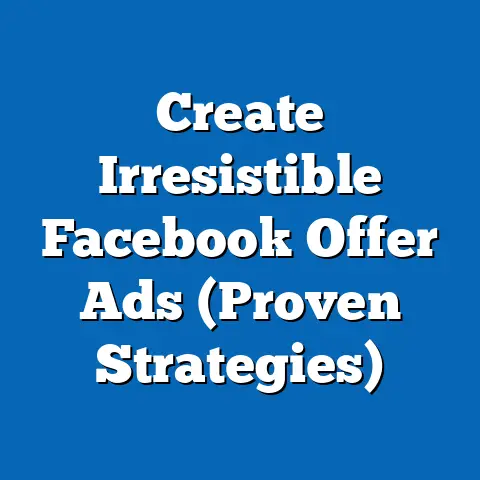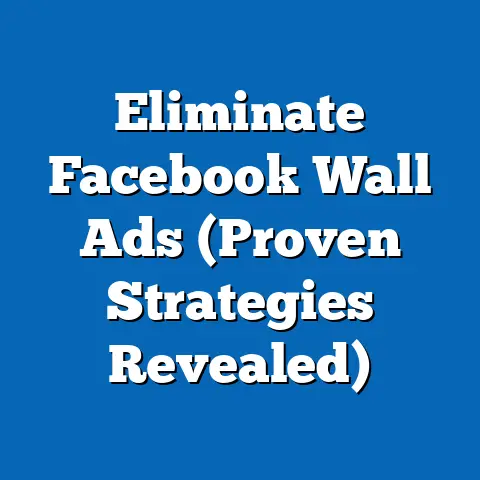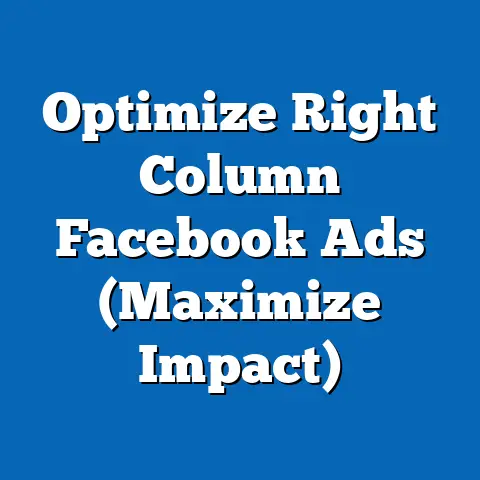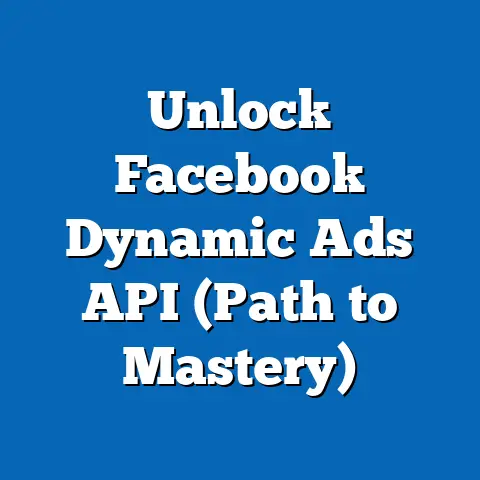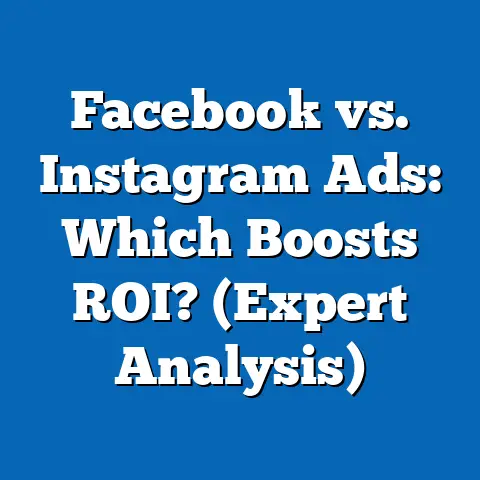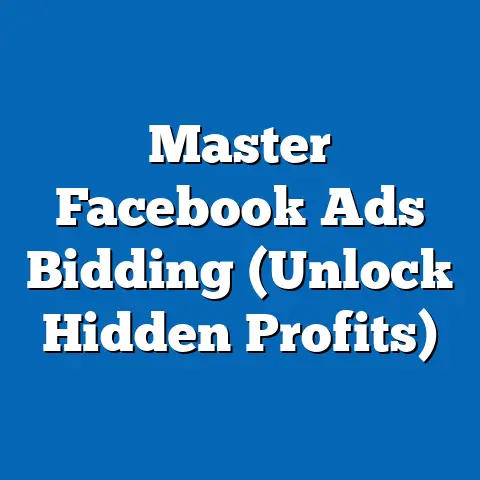Master Facebook Ads Endings (Pro Tips for Success)
Facebook advertising has become an indispensable tool for businesses looking to connect with their target audiences. As the digital landscape evolves, businesses are increasingly relying on Facebook Ads as a key strategy to reach potential customers and drive conversions. While many focus on the creative aspects of ads – the visuals, the witty copy – I’ve learned that the “ending” of a Facebook ad campaign is just as, if not more, crucial for achieving tangible results.
Think of it like this: you can have the most captivating opening line in a book, but if the ending falls flat, the whole experience is diminished. Similarly, your Facebook ad can grab attention initially, but if it doesn’t lead the user to take a desired action, it’s essentially wasted potential.
Mastering the “endings” of Facebook Ads encompasses several key elements: crafting compelling calls-to-action (CTAs), precise audience targeting, optimizing ad placements, and diligently tracking performance. These components work in synergy to guide potential customers toward taking the next step, whether that’s making a purchase, signing up for a newsletter, or simply engaging with your brand.
Understanding the Importance of Facebook Ads Endings
The endings of your Facebook Ads are the unsung heroes of your marketing campaigns. They’re not just an afterthought; they’re the final push that can make or break your ad’s effectiveness. I’ve seen firsthand how a well-crafted ending can turn a passive observer into an active customer.
Think of your ad as a journey. The beginning grabs their attention, the middle presents your offer, and the ending guides them to the destination: conversion. Without a clear and compelling ending, potential customers are left wondering, “Okay, what now?” and are likely to move on without taking any action.
Why are endings so critical?
- Driving Action: The primary goal of any ad is to prompt a specific action. The ending is where you explicitly tell the user what you want them to do, whether it’s “Shop Now,” “Learn More,” or “Sign Up.”
- Boosting Engagement: A strong ending encourages users to interact with your brand. This can lead to increased website traffic, higher conversion rates, and improved brand awareness.
- Improving ROI: By optimizing your ad endings, you can maximize the return on your advertising investment. A well-crafted ending ensures that your ad spend is driving tangible results.
Common Pitfalls to Avoid:
- Vague or Missing CTAs: A CTA that is unclear or absent leaves users confused about what to do next.
- Misaligned Messaging: If the ending doesn’t align with the overall message of the ad, it can create a disjointed experience and deter users from taking action.
- Ignoring Audience Targeting: Reaching the wrong audience means your ad, no matter how well-crafted, will likely fall flat.
Case Study: I once worked with an e-commerce client who was struggling to convert Facebook ad clicks into sales. Their ads were visually appealing and targeted a relevant audience, but their conversion rates were low. After analyzing their ads, I realized that their CTAs were weak and lacked a sense of urgency. By implementing stronger, more compelling CTAs like “Shop Now and Get 20% Off!” and “Limited Time Offer: Buy Now,” we saw a significant increase in sales. This simple change in the ad ending made all the difference.
Key Takeaway: Don’t underestimate the power of the ad ending. It’s the key to driving action, boosting engagement, and maximizing your ROI. Always ensure that your ad ending is clear, compelling, and aligned with your overall campaign objectives.
Crafting Compelling Calls-to-Action
Calls-to-action (CTAs) are the heart of your ad endings. They’re the direct prompts that tell users what you want them to do. A well-crafted CTA can be the difference between a passive viewer and an active customer. Over the years, I’ve experimented with countless CTAs and have learned what works and what doesn’t.
Understanding the Psychology of CTAs:
CTAs work by tapping into basic psychological principles. They create a sense of urgency, provide clear direction, and offer value to the user. Here are a few key psychological elements to consider:
- Urgency: Phrases like “Limited Time Offer” or “Shop Now Before It’s Gone” create a sense of urgency, encouraging users to act quickly.
- Clarity: A clear and concise CTA leaves no room for confusion. Users should know exactly what will happen when they click the button.
- Value Proposition: Highlight the benefit of taking action. For example, “Get Your Free Ebook” or “Start Your Free Trial Today.”
Types of CTAs and When to Use Them:
- Shop Now: Ideal for e-commerce businesses looking to drive immediate sales.
- Learn More: Perfect for informational ads or those promoting educational content.
- Sign Up: Great for building your email list or encouraging users to create an account.
- Download: Use this CTA when offering a free resource like an ebook or template.
- Contact Us: Suitable for businesses looking to generate leads or provide customer support.
- Book Now: Ideal for service-based businesses like restaurants, salons, or hotels.
- Watch More: Use this CTA to encourage users to view more video content.
Pro Tips for Creating Compelling CTAs:
- Use Strong Action Verbs: Start your CTA with a strong action verb like “Shop,” “Learn,” “Sign Up,” or “Download.”
- Keep it Concise: Aim for a CTA that is short, sweet, and to the point.
- Create a Sense of Urgency: Use phrases like “Limited Time Offer” or “Shop Now Before It’s Gone” to encourage immediate action.
- Highlight the Value Proposition: Clearly communicate the benefit of taking action. For example, “Get Your Free Ebook” or “Start Your Free Trial Today.”
- Align with Campaign Objectives: Ensure that your CTA aligns with the overall objective of your ad campaign.
Examples of Successful CTAs:
- “Shop Now and Get 20% Off!” This CTA combines urgency with a clear value proposition, making it highly effective for driving sales.
- “Download Your Free Guide to Facebook Advertising” This CTA offers a valuable resource in exchange for a user’s email address, making it great for lead generation.
- “Start Your 30-Day Free Trial Today” This CTA encourages users to try your product or service risk-free, making it a low-commitment way to engage with your brand.
A/B Testing Your CTAs:
I always recommend A/B testing different CTAs to see which ones resonate best with your target audience. Try testing different wording, button colors, and placements to optimize your ad endings.
Key Takeaway: Your CTA is the final push that drives action. Use strong action verbs, create a sense of urgency, highlight the value proposition, and always align your CTA with your campaign objectives. Don’t be afraid to A/B test different CTAs to find the ones that work best for your audience.
Targeting the Right Audience for Maximum Impact
You can have the most compelling ad in the world, but if it’s shown to the wrong audience, it’s like shouting into the void. Audience targeting is the cornerstone of effective Facebook advertising, and it plays a crucial role in ensuring that your ad endings resonate with the right people. I’ve spent countless hours refining audience segments and have seen firsthand the impact that precise targeting can have on campaign performance.
Leveraging Facebook’s Targeting Options:
Facebook offers a wide range of targeting options that allow you to reach specific users based on their demographics, interests, behaviors, and more. Here are a few key targeting options to consider:
- Demographics: Target users based on age, gender, education, location, and other demographic factors.
- Interests: Reach users who have expressed interest in specific topics, hobbies, or brands.
- Behaviors: Target users based on their online behavior, such as purchase history, device usage, and travel habits.
- Custom Audiences: Upload your own customer data to create custom audiences based on email lists, website visitors, or app users.
- Lookalike Audiences: Expand your reach by targeting users who are similar to your existing customers.
Crafting Audience Segments That Align with Campaign Goals:
The key to effective audience targeting is to create segments that align with your campaign goals. For example, if you’re promoting a new line of organic skincare products, you might target users who are interested in natural beauty, eco-friendly products, and healthy living.
Pro Tips for Audience Targeting:
- Start with a Broad Audience: Begin with a broad audience and gradually narrow it down based on performance data.
- Use Layered Targeting: Combine multiple targeting options to create more specific audience segments.
- Exclude Irrelevant Audiences: Exclude audiences that are unlikely to be interested in your product or service.
- Utilize Custom Audiences: Leverage your own customer data to create highly targeted audiences.
- Experiment with Lookalike Audiences: Expand your reach by targeting users who are similar to your existing customers.
A/B Testing Different Audience Segments:
I always recommend A/B testing different audience segments to find the best fit for your ad endings. Try testing different demographics, interests, and behaviors to see which ones generate the highest engagement and conversion rates.
Case Study: I worked with a local restaurant that was struggling to attract new customers. Their Facebook ads were visually appealing, but they weren’t reaching the right audience. After analyzing their customer base, I realized that their ideal customers were young professionals who lived within a 5-mile radius of the restaurant. By targeting this specific audience with ads featuring mouthwatering photos of their food and a CTA to “Book Now,” we saw a significant increase in reservations.
Key Takeaway: Audience targeting is essential for ensuring that your ad endings resonate with the right people. Leverage Facebook’s targeting options to create segments that align with your campaign goals, and always A/B test different audiences to find the best fit for your ads.
Optimal Ad Placements and Formats
Where your ad appears and how it’s presented can significantly impact the effectiveness of your ad endings. Facebook offers a variety of ad placements and formats, each with its own unique strengths and weaknesses. I’ve learned through trial and error which placements and formats work best for different types of ads and target audiences.
Understanding Facebook Ad Placements:
- Facebook Feed: Ads appear in the news feed alongside organic content. This is the most common ad placement and is ideal for reaching a broad audience.
- Facebook Stories: Ads appear between users’ stories. This placement is great for capturing attention with visually engaging content.
- Facebook Marketplace: Ads appear in the Marketplace, where users buy and sell items. This placement is ideal for reaching users who are actively looking to make a purchase.
- Instagram Feed: Ads appear in the Instagram feed alongside organic content. This placement is ideal for reaching a younger, more visually oriented audience.
- Instagram Stories: Ads appear between users’ stories on Instagram. This placement is great for capturing attention with visually engaging content.
- Audience Network: Ads appear on third-party websites and apps that are part of Facebook’s Audience Network. This placement allows you to expand your reach beyond Facebook and Instagram.
Choosing the Right Ad Format:
- Single Image Ads: These ads feature a single image and are ideal for showcasing a product or service.
- Single Video Ads: These ads feature a single video and are great for capturing attention and telling a story.
- Carousel Ads: These ads feature multiple images or videos that users can scroll through. They’re ideal for showcasing a range of products or features.
- Collection Ads: These ads feature a main video or image along with a collection of related products. They’re ideal for e-commerce businesses looking to drive sales.
- Instant Experience Ads: These ads open into a full-screen experience on mobile devices. They’re great for creating immersive brand experiences.
Pro Tips for Ad Placements and Formats:
- Consider Your Target Audience: Choose placements and formats that are popular with your target audience.
- Align with Campaign Objectives: Select placements and formats that support your campaign objectives.
- Test Different Combinations: Experiment with different placements and formats to see which ones perform best.
- Optimize for Mobile: Ensure that your ads are optimized for mobile devices, as most Facebook users access the platform on their phones.
- Use High-Quality Visuals: Use high-quality images and videos that are visually appealing and engaging.
Case Study: I worked with a clothing retailer that was launching a new summer collection. We decided to use carousel ads to showcase the different pieces in the collection. We targeted users who were interested in fashion and summer trends and placed the ads in the Facebook and Instagram feeds. The carousel format allowed us to showcase multiple products in a single ad, and the visual appeal of the ads captured the attention of our target audience. As a result, we saw a significant increase in website traffic and sales.
Key Takeaway: Ad placements and formats play a crucial role in the effectiveness of your ad endings. Consider your target audience, align with your campaign objectives, and test different combinations to find the ones that work best for your ads.
Analyzing Performance and Making Data-Driven Decisions
Mastering Facebook Ads endings isn’t a one-time effort; it’s an ongoing process of analysis, optimization, and refinement. Performance tracking and analytics are essential for understanding what’s working, what’s not, and how to improve your campaigns. I’ve learned to rely on data to guide my decisions and have seen firsthand how it can transform campaign performance.
Key Performance Indicators (KPIs) to Focus On:
- Click-Through Rate (CTR): The percentage of users who click on your ad after seeing it. A high CTR indicates that your ad is relevant and engaging.
- Conversion Rate: The percentage of users who take a desired action after clicking on your ad, such as making a purchase or signing up for a newsletter. A high conversion rate indicates that your ad ending is effective.
- Cost Per Click (CPC): The amount you pay each time someone clicks on your ad. A low CPC indicates that your ad is efficiently reaching your target audience.
- Cost Per Conversion (CPC): The amount you pay for each conversion. A low CPA indicates that your ad is effectively driving results.
- Return on Ad Spend (ROAS): The amount of revenue you generate for every dollar you spend on advertising. A high ROAS indicates that your ad campaign is profitable.
- Engagement Metrics: Metrics like likes, comments, and shares indicate how users are interacting with your ad.
Interpreting Ad Performance Data:
- Low CTR: If your CTR is low, it may indicate that your ad is not relevant or engaging to your target audience. Try refining your targeting, improving your ad creative, or testing different ad formats.
- Low Conversion Rate: If your conversion rate is low, it may indicate that your ad ending is not effective. Try improving your CTA, aligning your messaging, or optimizing your landing page.
- High CPC or CPA: If your CPC or CPA is high, it may indicate that your ad is not efficiently reaching your target audience. Try refining your targeting, improving your ad quality, or testing different ad placements.
- Low ROAS: If your ROAS is low, it may indicate that your ad campaign is not profitable. Try optimizing your targeting, improving your ad creative, or adjusting your bidding strategy.
Pro Tips for Analyzing Performance:
- Set Up Conversion Tracking: Ensure that you have proper conversion tracking set up so you can accurately measure the results of your ad campaigns.
- Use Facebook Ads Manager: Utilize Facebook Ads Manager to track your ad performance and identify areas for improvement.
- Analyze Data Regularly: Analyze your ad performance data regularly to identify trends and patterns.
- A/B Test Everything: A/B test different elements of your ads, such as targeting, creative, and CTAs, to optimize your campaigns.
- Stay Up-to-Date: Stay up-to-date with the latest Facebook advertising features and best practices.
Case Study: I worked with an online course provider that was struggling to generate leads through Facebook ads. After analyzing their ad performance data, I realized that their ads were generating a lot of clicks, but few users were signing up for their free trial. I identified that the landing page experience was poor. By optimizing their landing page and improving their CTA, we saw a significant increase in lead generation.
Key Takeaway: Performance tracking and analytics are essential for mastering Facebook Ads endings. Focus on key performance indicators, interpret ad performance data, and use data-driven insights to refine your targeting, messaging, and ad endings for future campaigns.
Conclusion
Mastering Facebook Ads endings is not just about creating visually appealing ads; it’s about crafting a seamless and persuasive experience that guides potential customers toward taking action. By focusing on the key elements of compelling CTAs, precise audience targeting, optimal ad placements, and diligent performance tracking, you can transform your Facebook advertising efforts from a cost center to a powerful driver of business growth.
Remember, the digital marketing landscape is constantly evolving, and continuous learning and adaptation are essential for staying ahead of the curve. Keep experimenting with new strategies, analyzing your results, and refining your approach based on data-driven insights.
I encourage you to implement the pro tips shared throughout this article and to approach your Facebook advertising efforts with a mindset of continuous improvement. By mastering the endings of your Facebook Ads, you can unlock the full potential of this powerful platform and achieve unprecedented levels of success.
So, go out there and create Facebook Ads that not only capture attention but also drive conversions and maximize your ROI. The power to transform potential interest into actionable results lies in your hands. Good luck, and happy advertising!

